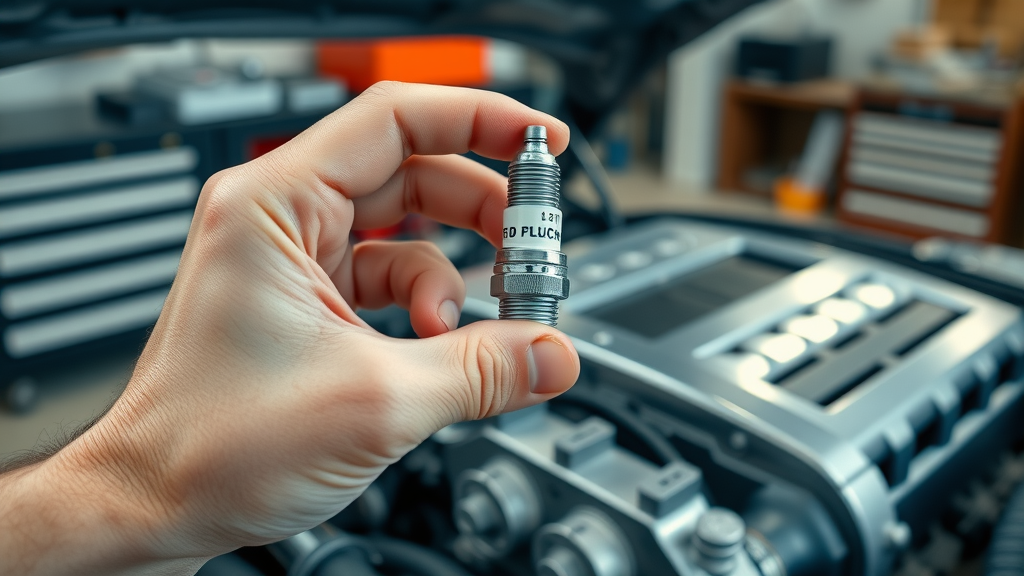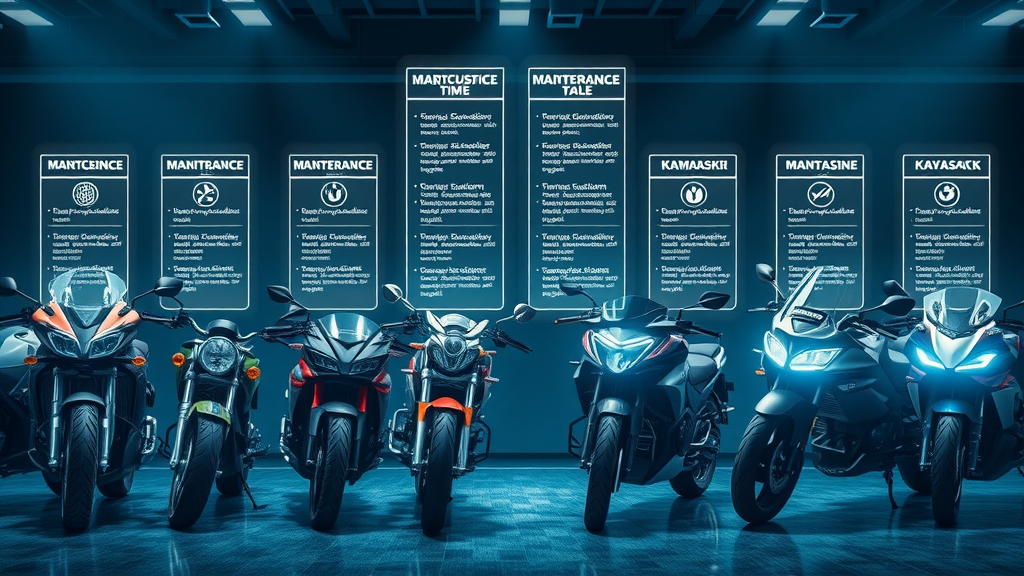Did you know that over 50% of motorcycle breakdowns happen because riders ignore or forget their maintenance schedules? Whether you’re a daily commuter or a weekend adventurer, your motorcycle maintenance schedule is the invisible line between smooth rides and sudden breakdowns. In this no-nonsense guide, you’ll uncover everything you need to master maintenance, boost safety, and enjoy a worry-free journey every time you hit the road. Read on to safeguard your ride and avoid those costly surprises!

Understanding the Importance of a Motorcycle Maintenance Schedule
-
Did you know that over 50% of motorcycle breakdowns are linked to ignored maintenance schedules? Learn how a well-structured motorcycle maintenance schedule can prevent unexpected repairs and keep you safer on the road.
A meticulous motorcycle maintenance schedule is your strongest defense against mechanical failures and expensive repairs. It doesn’t just keep your engine healthy—it’s also pivotal for your safety. Every moving part, from the drive belt to the brake pads and fork oil, relies on timely attention to avoid unexpected issues.
Most riders neglect regular checks, but maintaining a consistent maintenance schedule means your brake fluid won’t be running low, your engine oil will do its job, and every filter change will help your bike breathe easier.
Imagine the confidence of knowing your bike’s maintenance checklist is up to date! With proper scheduling, you reduce the risk of minor issues escalating into major failures that leave you stranded. Whether you ride a dirt bike or a touring machine, following your maintenance interval protects more than just the bike—it safeguards your adventures and peace of mind.

Maximize Safety and Longevity with the Right Motorcycle Maintenance Schedule
-
Explore the big-picture: why following a detailed motorcycle maintenance schedule drastically improves safety, longevity, and performance for all riders.
Staying loyal to your motorcycle maintenance schedule is the best way to guarantee your ride’s maximum lifespan and optimal performance. Every skipped maintenance task—whether an oil filter change or a simple brake pad inspection—chips away at your motorcycle’s reliability. Safety isn’t just about riding technique; it’s also about ensuring the foundation of your bike is strong.
Regularly checking the maintenance checklist keeps all systems go—from air filter changes that maximize fuel efficiency, to chain and sprocket inspections that prevent sudden breakdowns on the open road. A well-maintained bike responds better, feels more stable, and inspires more confidence in every scenario, whether in city traffic or on mountain twisties.
Over the long time you own your motorcycle, adhering to a carefully planned maintenance schedule reduces cumulative wear, stopping expensive damage before it happens. Regular inspections catch small issues—like worn brake pads or under-lubricated chain and sprockets—before they affect your safety or wallet. The result? Your motorcycle stays new for longer, and every journey is as smooth as the first.
What You’ll Gain from This Motorcycle Maintenance Schedule Guide
-
How to customize your motorcycle maintenance schedule for different motorcycle types
-
Critical service intervals you can't afford to miss
-
Expert-backed maintenance checklists for every season
-
Tips for keeping consistent with your motorcycle maintenance routine

Key Elements of a Motorcycle Maintenance Schedule
What Makes an Effective Motorcycle Maintenance Schedule?
-
Manufacturer guidelines vs. real-world riding demands
-
Frequency of service intervals and critical inspections
-
Typical maintenance checklist items included in schedules
Every motorcycle maintenance schedule starts with a solid foundation: the manufacturer’s service manual. While factory recommendations are essential, they may not always match your unique riding style or environment. For example, a dirt bike tackling muddy trails will have different fork oil and air filter needs compared to a sport bike cruising city streets. Real-world conditions will often require you to adjust your maintenance interval up or down to match these realities.
“ An effective motorcycle maintenance schedule is your best protection against both dangerous failures and costly repairs. ”
The core of any maintenance schedule involves critical elements: routine oil and oil filter changes, checking brake pads and brake fluid, adjusting chain and sprockets, and periodic inspection of the engine oil and cooling system. Service intervals—both mileage-based and time-based—dictate how frequently you should check or replace vital components. Following a maintenance checklist tailored to your motorcycle makes it easy to stay on top of these tasks and never skip a beat.

Essential Motorcycle Maintenance Checklist for Every Rider
-
Inspect and replace oil filter and oil change at recommended service intervals
-
Regularly check and replace brake pads and brake fluid
-
Ensure spark plug and air filter are clean and functional
-
Check and lubricate chain and sprocket regularly
-
Tire inspection for pressure, wear and balance
This maintenance checklist forms the backbone of every motorcycle maintenance plan. At each service interval, check your oil filter and perform a full oil change using fully synthetic or manufacturer-approved engine oil. This keeps internal moving parts clean and lubricated, fending off the buildup of contaminants that cause wear.
Don’t neglect your brake system—inspect your brake pads for wear, check the brake fluid, and watch for signs of fading stopping power. Air filters require cleaning or replacement to maintain consistent airflow and fuel efficiency, while a healthy spark plug ensures strong ignition. Lastly, keep your chain and sprockets free from debris, well-lubricated, and correctly tensioned to avoid breakage and maximize efficiency.
Tires are your only connection to the road. A part of your routine maintenance task should always be a tire check—look for uneven wear, proper inflation, and check wheel balance. This simple but critical habit extends tire life, improves handling, and drastically reduces the chance of blowouts or slips.

Recommended Service Intervals in Your Motorcycle Maintenance Schedule
Understanding Service Intervals for Longevity
-
What service interval really means for your motorcycle maintenance
-
Choosing the right service intervals based on riding style and environment
-
Typical mileage/time-based benchmarks
Service intervals are the heartbeat of your motorcycle maintenance schedule . Defined by either elapsed mileage or time, these tell you when critical maintenance tasks must be performed. For most motorcycles, an oil change and oil filter swap is needed every 3,000–6,000 miles or every 6–12 months—whichever comes first. However, real-life factors like daily commuting, exposure to harsh climates, or off-road adventures may necessitate a shorter service interval.
Manufacturers typically recommend servicing things like your chain and sprocket, brake pad, and brake fluid at set intervals. Yet, for aggressive riders or bikes exposed to dusty environments, the maintenance interval shrinks. Properly understanding and adapting these service intervals is vital for stretching the life of your drive belt, rear shock, and even your spark plug.
The service manual is always your starting point—but keep a close eye on symptoms between scheduled inspections. Any change in handling, braking, or starting could indicate it’s time to check items outside the normal maintenance checklist. Adapting your schedule keeps your motorcycle performing its best, regardless of how or where you ride.
How to Track Your Motorcycle's Maintenance Schedules Efficiently
-
Digital and paper tracking methods
-
Why detailed record keeping saves money and avoids missed maintenance tasks
Sticking to a motorcycle maintenance schedule is much easier with reliable tracking. Use a smartphone app dedicated to motorcycle care or a simple logbook; both methods have their merits. Apps can send reminders for each maintenance interval and store digital copies of your service manual, while a physical logbook—kept near your bike—helps you quickly reference completed tasks, from oil changes to last chain and sprocket service.
Good records are more than just organized—they’re money-savers. A meticulous maintenance checklist ensures nothing is overlooked, and every oil filter change and brake pad swap is on record. This helps you avoid repeating or missing services that could impact performance or void your warranty.
Whether you’re managing one bike or an entire family fleet, consistent documentation boosts resale value and makes troubleshooting easier if issues arise. It puts you in charge of the maintenance schedule, not at its mercy.
|
|
|
|
Sample Motorcycle Maintenance Schedule Table (Task vs. Mileage/Months) |
|
Maintenance Task |
Every 500 mi/1 month |
Every 3,000 mi/6 months |
Every 6,000 mi/12 months |
|---|---|---|---|
|
Check Tire Pressure & Condition |
✔️ |
✔️ |
✔️ |
|
Change Oil & Replace Oil Filter |
|
✔️ |
✔️ |
|
Check & Adjust Chain/Sprocket |
✔️ |
✔️ |
✔️ |
|
Inspect Brake Pads/Fluid |
|
✔️ |
✔️ |
|
Replace Air Filter & Spark Plug |
|
|
✔️ |
Motorcycle Maintenance: Critical Tasks Explained
Oil Change and Oil Filter: The Lifeblood of Motorcycle Maintenance
-
Why regular oil changes and timely oil filter replacement matter
-
Consequences of stretching intervals
-
Recommended oil types and best practices
An oil change and fresh oil filter are vital for protecting your engine’s moving parts. Engine oil lubricates, cools, and cleans internal components, while the oil filter captures harmful contaminants. Stretching these intervals allows grime to build up, wearing out your engine prematurely and possibly resulting in a costly overhaul.
Using fully synthetic oil can extend the interval between oil changes, but you should always consult your service manual for the correct specification. Change the oil and oil filter according to your maintenance schedule—don’t wait for performance to dip. The reward: a happy engine, consistent power delivery, and more miles between major repairs.
Brake Pads and Brake System Inspection in Maintenance Schedules
-
Spotting signs of brake pad wear
-
Best practices for brake fluid maintenance and bleed intervals
Regular brake pad and brake fluid checks are an essential safety step in your motorcycle maintenance schedule. Brake pads wear gradually, often without you noticing until braking performance drops off. If the friction material is worn close to the backing plate—or you hear a metallic scraping sound—it’s time for immediate replacement.
Your brake fluid should be clear and at the recommended level in the reservoir. Over time, moisture can creep in, degrading performance and possibly damaging internal brake system parts. Flushing and replacing brake fluid at factory-specified intervals—usually every 1 to 2 years—guarantees safe stopping whatever the conditions.
Chain and Sprocket Maintenance: Maximizing Efficiency
-
Inspection, cleaning, and lubrication cycles in your maintenance schedule
-
How to identify worn sprockets and chain stretch
The chain and sprocket system transfers power from your engine to the back wheel, making it crucial to include these components in your regular maintenance checklist. Neglecting lubrication or tension checks leads to a noisy, jerky ride—or even catastrophic failure at speed. Clean and lubricate your chain frequently; use a dedicated chain cleaner and a high-quality lube recommended in your service manual.
During inspections, look for kinks, tight spots, and excessive stretch. Worn sprockets can be spotted by hooked or pointed teeth. Replacing both clutch and driven sprockets together with the chain is best practice during maintenance intervals.
Air Filter and Spark Plug Care for Reliable Performance
-
Recommended inspection and replacement intervals
-
Symptoms of clogged air filter and worn spark plug
The air filter and spark plug are key to your motorcycle starting, idling, and running reliably. Clogged air filters restrict air flow, leading to poor fuel economy, sluggish acceleration, and even engine damage if left unchecked.
Spark plugs should be checked and cleaned or replaced according to your maintenance schedule. Symptoms of a failing spark plug include hard starting, rough running, or misfires. Always use the correct plug type from your manufacturer’s guidance for optimal performance and efficiency.

Seasonal and Annual Maintenance Tasks
-
Pre-season motorcycle maintenance checklist
-
Post-season motorcycle storage and protection routines
-
Annual service intervals not to overlook
Seasonal changes can quietly impact your motorcycle maintenance schedule . At the start of each riding season, inspect the battery, test lights, check fluid levels (including coolant and fork oil), and ensure the tires are up to pressure. During winter storage, clean and lubricate all moving parts, fill the tank, and connect a battery tender.
Annual checks—regardless of mileage—should address less frequently serviced items: coolant level, valve adjustments, head bearings, rear shock inspection, and a complete maintenance checklist review. These rare but vital steps keep your motorcycle ready for riding any time of year.
How to Perform a Complete Motorcycle Maintenance Checklist (visual demo)
Advanced Motorcycle Maintenance Schedule: Going Beyond the Basics
Fluid Checks: Coolant and Hydraulic Systems
-
Consequences of skipping coolant and hydraulic fluid inspection
-
Signs of wear and when to replace fluids
The cooling system and hydraulic fluids play a vital but often overlooked role in your motorcycle maintenance schedule . Without routine checks, coolant level can drop below safe thresholds, leading to overheating or engine failure. Inspect coolant for clarity and the recommended strength or color; murky or rusty liquid indicates immediate attention is needed.
Likewise, hydraulic clutch or brake systems require fluid flushes at intervals recommended by your manufacturer, or when the fluid appears cloudy. Skipping these checks can cause poor shifting, spongy brakes, or system leaks—problems that are both preventable and expensive if neglected for a long time.
Electrical System Checks in Your Maintenance Schedules
-
Battery inspection, charging system, and lighting checks
-
Common electrical faults and how a maintenance schedule can help avoid them
A healthy battery and robust charging system are non-negotiable parts of your routine maintenance task list. Inspect the battery for clean terminals, secure mounting, and check the voltage regularly. Dim lights or repeated dead batteries point to deeper charging issues.
Regularly inspect all electrical connectors, relays, and fuses for signs of wear or corrosion. By including these checks in your maintenance intervals, you’ll catch electrical faults early—and enjoy reliable starting and lighting on every ride.
Professional vs. DIY Motorcycle Maintenance
-
Which maintenance tasks should be left to professionals
-
When DIY servicing can complement scheduled maintenance
While a dedicated enthusiast can tackle many items on the maintenance checklist , some procedures—like valve clearance checks or advanced diagnostics—are best left to a trusted professional. Involving an expert for complex work maintains your warranty, guarantees safety, and helps catch issues even diligent owners might miss.
Everyday tasks such as oil changes, chain adjustment, and basic inspections are perfectly suited to DIY. Knowing your limits and the boundaries of each maintenance task ensures every job is done safely and correctly, maximizing the value of your motorcycle maintenance schedule.

Troubleshooting Common Motorcycle Maintenance Mistakes
-
Missing service intervals and overdue service intervals
-
Overlooking maintenance checklist details
-
Forgetting seasonal motorcycle maintenance tasks
-
Solutions for catching up on lapsed motorcycle maintenance schedules
One of the most common pitfalls riders face is missing a scheduled service interval or neglecting items on the maintenance checklist . Forgetting routine checks causes a ripple effect—outdated brake fluid, worn-out air filters, slack chains, and even neglected spark plugs. Over time, these overlooked maintenance tasks accelerate wear, reduce performance, and risk total breakdown.
If you’ve missed maintenance intervals, don’t panic. Catch up by following your service manual’s recommended tasks, prioritizing immediate safety items (brakes, oil, tires), and then performing a thorough catch-up maintenance. Consistency from this point forward will keep you and your motorcycle safe and reliable.

Comparing Motorcycle Maintenance Schedules Across Various Brands
|
|
|
|
|
|
Brand-Specific Service Interval Comparisons |
|
Brand |
Oil Change |
Brake Pads |
Chain and Sprocket |
Air Filter |
Spark Plug |
|---|---|---|---|---|---|
|
Honda |
Every 4,000 mi / 6 mo |
Check every 4,000 mi |
Every 4,000 mi |
Every 8,000 mi |
Every 8,000 mi |
|
Yamaha |
Every 3,000 mi / 6 mo |
Check every 3,000 mi |
Every 3,000 mi |
Every 6,000 mi |
Every 6,000 mi |
|
Harley-Davidson |
Every 5,000 mi / 12 mo |
Check every 5,000 mi |
Belt: check every 5,000 mi |
Every 10,000 mi |
Every 10,000 mi |
|
BMW |
Every 6,000 mi / 12 mo |
Check every 6,000 mi |
Shaft: inspect every 6,000 mi |
Every 12,000 mi |
Every 12,000 mi |
|
Kawasaki |
Every 3,000 mi / 6 mo |
Check every 3,000 mi |
Every 3,000 mi |
Every 6,000 mi |
Every 6,000 mi |

Brand Comparison: How Service Intervals Differ and What to Watch Out For
Mastering Your Motorcycle Maintenance Schedule: Proactive Tips for Success
-
Apps and reminders for service intervals
-
Finding trusted mechanics
-
Recording your maintenance schedule and maintenance task completions
Take charge of your motorcycle maintenance schedule with the right blend of technology and traditional methods. Smartphone apps like MyRide or service interval reminders can alert you ahead of time when maintenance is due. Pair this with a physical maintenance log to double your coverage.
Equally important? Build a relationship with a reputable mechanic—someone who knows your bike and can spot upcoming issues before they become problems. Meticulously recording every maintenance task creates a bulletproof history that enhances resale value and keeps you safe.

People Also Ask: What is the service schedule for a motorcycle?
A motorcycle service schedule is a structured calendar or mileage-based plan, usually recommended by the manufacturer, which outlines when critical components need inspection, servicing, or replacement. Service intervals typically cover oil changes, brake checks, chain maintenance, and other essential items.
People Also Ask: What regular maintenance does a motorcycle need?
Regular motorcycle maintenance should include oil and oil filter replacement, brake inspection (pads and fluid), chain and sprocket lubrication and adjustment, tire checking, air filter and spark plug replacement, and battery inspection.
People Also Ask: How often should I have my motorcycle serviced?
Motorcycles should typically be serviced every 3,000 to 6,000 miles, or every 6-12 months, depending on usage and manufacturer recommendations. However, your maintenance schedule should always be tailored to your personal riding habits and motorcycle make/model.
People Also Ask: What is a full service on a motorcycle?
A full service includes all routine checks and replacements: oil and filter change, complete brake system inspection, chain tightening and lubrication, coolant top-up, electrical system test, tire and wheel check, and an overall assessment of the motorcycle’s condition.
Frequently Asked Questions About Motorcycle Maintenance Schedules
-
How do I know which maintenance schedule applies to my motorcycle?
-
Are aftermarket maintenance checklists reliable?
-
How can I quickly tell if my motorcycle needs unscheduled maintenance?
"Sticking to a detailed maintenance schedule means fewer surprises, whether you ride daily or only on weekends."
Best Practices for Sticking with Your Motorcycle Maintenance Schedule
-
Keep a visible logbook or tracking app
-
Block recurring time on your calendar for service intervals
-
Build a relationship with a reputable mechanic

Start Your Proactive Motorcycle Maintenance Schedule Now
-
Don't risk costly repairs or dangerous breakdowns—take charge of your motorcycle maintenance schedule. For personalized plans and professional servicing, Call Us Today: 847-458-4858
Take immediate action: review your maintenance checklist, track your service intervals, and partner with a trusted mechanic to keep your ride safe, smooth, and adventure-ready all year!
Maintaining a consistent motorcycle maintenance schedule is crucial for ensuring your bike’s longevity and your safety on the road. For a comprehensive checklist that covers pre-ride inspections, routine maintenance tasks, and seasonal upkeep, refer to the “Motorcycle Maintenance Checklist: Keep Your Bike in Peak Condition” provided by Moto News Blog. This resource offers detailed guidance on essential maintenance practices to keep your motorcycle performing optimally.
Additionally, for brand-specific maintenance schedules, “Motorcycle Maintenance 101: Harley-Davidson® Scheduled Maintenance” by Barnes Harley-Davidson® outlines the recommended service intervals and tasks tailored for Harley-Davidson models. This guide ensures that owners adhere to the manufacturer’s guidelines for optimal performance and safety.
By consulting these resources, you can develop a tailored maintenance plan that suits your motorcycle’s specific needs and your riding habits, ensuring a safe and enjoyable riding experience.
 Add Row
Add Row  Add
Add 



Write A Comment